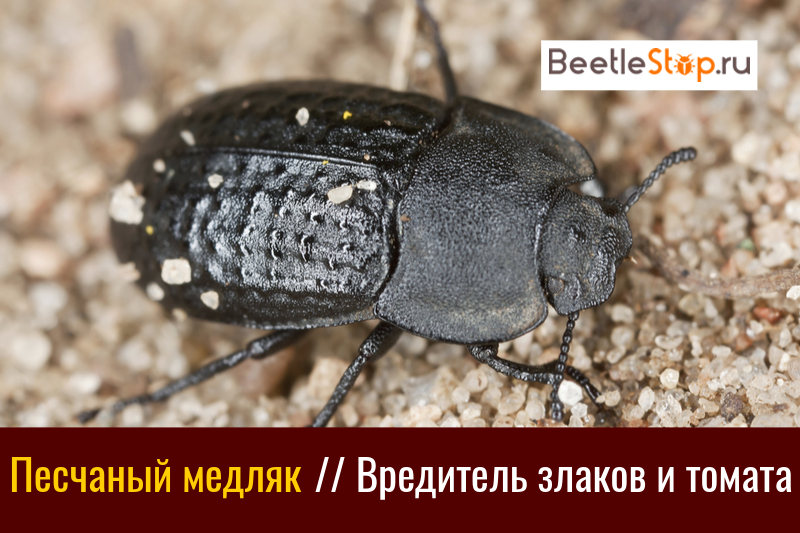Sand lag - a beetle that destroys seedlings
Among the pests of the steppe zone stands a sand lark. The black beetle family beetle is a polyphage; it spoils grain, seedlings of cereals, sunflower, flax, tomato and other crops. Adults emerge from wintering in early spring, causing the greatest harm from April to mid-May. Shoots are harmed by adults and larvae. To combat them, agrotechnical measures and poisoned baits are used.

Morphological description of the species
The sand lag (Opatrum sabulosum) belongs to the genus Opatrum, the family of the Darkling. The adult body is oval with parallel sides, length 7-10 mm. The soil crust covering the body gives it a grayish or black tint. The clypeus hides the mouth organs, in the front part it has a semicircular notch through which the upper lip is visible. Convex cheeks slightly cover the surface of the eyes. Clypeus and cheeks covered with puncture. The eyes are convex with a deep emarginate leading edge. The maxillary palps have no extensions.
The forehead is covered with large dots of various shapes. The growth of small setae is directed back. Antennas 11-segmented, the last segment has a conical tip. Antennae short, their size not exceeding 1/3 of the length of the pronotum.
Pronotum more than long in width, granular cover. Among the punctures, two smooth tubercles are noticeable. The sides of the pronotum are arched, protruding. The front part is notched. The vertices of the protruding front and rear corners are flattened. Rigid elytra cover the longitudinal rows of large growths. The hind wings are reduced. Fore femur trihedral, convex, with short setae. Middle and back straight. Shins with spikes outward.
Information. Sexual dimorphism of beetles: in the male, the forelegs are not expanded, there is no hair brush on them.
Distribution area
Sand lard is found in regions with a warm and temperate climate. Beetles live in Central and Southern Europe, the foothills of Central Asia, in Mongolia, Kazakhstan. The pest affects the south of the European and Siberian parts of Russia, the Caucasus.
Reproduction and lifestyle
Beetles appear on the surface immediately after the snow cover has melted. A temperature of + 10-12 ° is acceptable for them. Adults lie in the winter diapause, buried in the ground. Insects do not like wet places, choose dry areas with sandy soil. Mating begins in April and lasts until the end of the month. Females lay eggs in pits up to 5 cm deep. Laying takes place in heaps of 3-10 pieces, the total number of eggs per season is up to 100 pieces.
Offspring development
The laying process is extended for a month, and 1 week is enough for the development of the embryo. Small larvae with a flattened-cylindrical body shape resemble wireworms. Coloring is gray or brown-yellow, head and chest are dark. There are eyes, on the clypeus two club-shaped spines. Body length 18 mm. On the sides are rows of spines, numbering 16-24 pieces. Larvae feed on decaying residues, rarely damage living plants. They develop 35-40 days.
In July pupate in the soil. Larvae of the late ovipositor turn into pupae in August. The pupal phase takes from 8 to 14 days. Its integument changes with maturation. The light pupa becomes light brown over time.Adult adults born in the fall do not leave the cradle until next year. In July, a second wave of pests appears. Their diet includes fresh and withered shoots, plant debris. With the onset of frost, beetles hide in shelters for the winter.
Information. The life expectancy of sand darlings is 2 years. They manage to lay eggs twice.
Malware
Sand lag is one of the polyphagous pests that feed on vegetable and cereal crops. The greatest harm to adults is caused by young seedlings. Traces of their effects are clearly visible on corn, tomatoes, sunflowers, cabbage, tobacco, flax. On seedlings, cereal beetles eat up leaves, on vegetables cotyledons. Malicious activity of adults ceases in July. At this time, larvae grow up. They eat pieces of the underground parts of plants.
Methods of struggle
The main measure to protect the crop from sand lard is to comply with agricultural regulations:
- early sowing;
- timely destruction of weeds, including on aisles;
- autumn plowing, which damages larvae;
- stubble peeling after harvesting;
- seed dressing.
Poison traps
Beetles love to accumulate in shelters and eat wilted plants. For them, bait is prepared from greens mixed with insecticides. For 200-500 g of plants, 2-10 g of a chemical preparation of the type "Aktara", "Karbofos", "Hexochloran" is taken. The number of poisoned traps 100 pieces per 1 ha of field. It remains only to remove dead pests.

